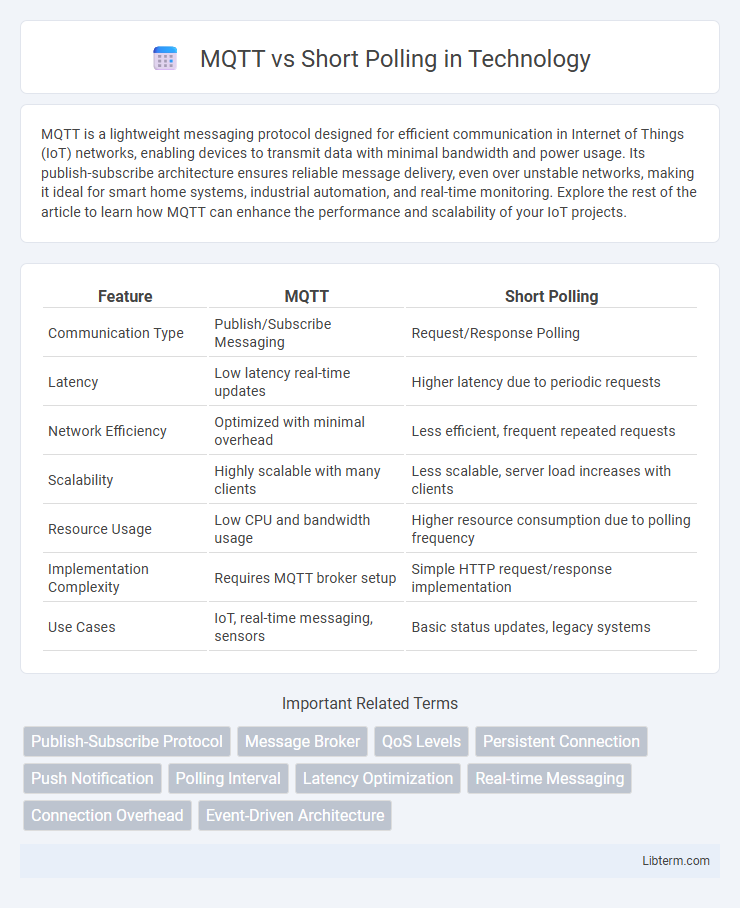MQTT is a lightweight messaging protocol designed for efficient communication in Internet of Things (IoT) networks, enabling devices to transmit data with minimal bandwidth and power usage. Its publish-subscribe architecture ensures reliable message delivery, even over unstable networks, making it ideal for smart home systems, industrial automation, and real-time monitoring. Explore the rest of the article to learn how MQTT can enhance the performance and scalability of your IoT projects.
Table of Comparison
| Feature | MQTT | Short Polling |
|---|---|---|
| Communication Type | Publish/Subscribe Messaging | Request/Response Polling |
| Latency | Low latency real-time updates | Higher latency due to periodic requests |
| Network Efficiency | Optimized with minimal overhead | Less efficient, frequent repeated requests |
| Scalability | Highly scalable with many clients | Less scalable, server load increases with clients |
| Resource Usage | Low CPU and bandwidth usage | Higher resource consumption due to polling frequency |
| Implementation Complexity | Requires MQTT broker setup | Simple HTTP request/response implementation |
| Use Cases | IoT, real-time messaging, sensors | Basic status updates, legacy systems |
Introduction to MQTT and Short Polling
MQTT (Message Queuing Telemetry Transport) is a lightweight messaging protocol designed for low-bandwidth, high-latency, or unreliable networks, commonly used in IoT applications to facilitate real-time, asynchronous communication between devices. Short Polling is a client-server communication method where the client repeatedly sends requests at fixed intervals to check for new data, which can lead to increased latency and higher network overhead. MQTT optimizes resource use by maintaining persistent connections and delivering messages only when available, whereas Short Polling may cause inefficient power and bandwidth consumption due to constant querying.
Core Principles of MQTT
MQTT operates on a publish-subscribe model, enabling lightweight, efficient messaging with minimal bandwidth use, ideal for IoT devices requiring real-time data exchange. Unlike short polling, which repeatedly sends requests at fixed intervals increasing network overhead, MQTT maintains persistent sessions and uses a broker to push messages only when new data is available, reducing latency and power consumption. Its core principles include minimizing packet size, ensuring reliable message delivery with Quality of Service (QoS) levels, and supporting lightweight session management for intermittent connectivity.
How Short Polling Works
Short Polling operates by having a client repeatedly send requests to a server at regular intervals to check for new data or updates, which can lead to increased latency and unnecessary network traffic when no new information is available. Unlike MQTT's efficient publish-subscribe model, Short Polling often results in wasted resources as the client may poll even when the server has no new data to send. This polling approach can cause slower response times and higher bandwidth consumption compared to MQTT's event-driven communication.
Communication Efficiency Comparison
MQTT outperforms short polling in communication efficiency by using a lightweight publish-subscribe protocol that minimizes bandwidth and reduces network traffic through persistent TCP connections. Unlike short polling, which repeatedly sends requests and often results in redundant data transfer and increased latency, MQTT ensures data is pushed only when updates occur, conserving device battery life and lowering server load. This efficiency makes MQTT ideal for IoT environments with constrained resources and high scalability requirements.
Latency and Real-Time Data Delivery
MQTT significantly reduces latency compared to short polling by maintaining a persistent connection that allows immediate data transmission once an event occurs, ensuring near real-time data delivery. Short polling, relying on repeated client requests at fixed intervals, introduces inherent delays and increased network overhead, which can compromise timely updates. The efficient publish/subscribe model of MQTT enables faster responsiveness crucial for applications requiring minimal latency and continuous data flow.
Scalability and Network Load
MQTT's publish-subscribe model significantly enhances scalability by allowing thousands of clients to maintain persistent connections without continuous polling, reducing network overhead. In contrast, short polling requires clients to repeatedly send requests to check for updates, increasing network load and server processing demands as the number of clients grows. MQTT's efficient message delivery minimizes bandwidth use and latency, making it ideal for large-scale IoT deployments compared to the higher resource consumption typical of short polling.
Resource Utilization and Power Consumption
MQTT significantly reduces resource utilization and power consumption compared to short polling by maintaining a persistent connection that transmits only when necessary, minimizing network overhead. Short polling frequently checks the server at fixed intervals regardless of data availability, leading to higher CPU usage and energy drain on devices, especially in constrained IoT environments. Efficient session management and lightweight messaging in MQTT optimize battery life and bandwidth, making it ideal for low-power devices and resource-limited networks.
Security Considerations
MQTT employs robust security protocols such as TLS/SSL encryption and client authentication to ensure data integrity and confidentiality during message transmission, making it well-suited for IoT environments. Short polling, while simpler, often lacks built-in security features, relying heavily on HTTPS or VPNs for secure data exchange, which can introduce latency and overhead. The persistent connection in MQTT reduces exposure to man-in-the-middle attacks compared to the repetitive connection establishment in short polling, enhancing overall security resilience.
Use Case Scenarios
MQTT excels in use cases requiring real-time, low-bandwidth communication such as IoT device telemetry, home automation, and industrial sensor networks due to its lightweight publish-subscribe model and persistent connections. Short polling is better suited for scenarios with sporadic data updates or where server push mechanisms are unavailable, such as simple web applications or legacy systems that periodically check for updates without maintaining continuous connections. The choice depends on factors like network constraints, device capabilities, and the need for immediate versus periodic data retrieval.
Conclusion: Choosing Between MQTT and Short Polling
MQTT offers a lightweight, efficient protocol ideal for real-time, low-bandwidth IoT applications, ensuring minimal latency and reduced power consumption compared to short polling. Short polling, while simpler to implement, causes higher network overhead and increased latency due to frequent, repetitive server requests. For scalable, energy-sensitive deployments requiring immediate data updates, MQTT is the preferred choice over short polling.
MQTT Infographic

 libterm.com
libterm.com